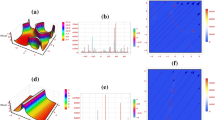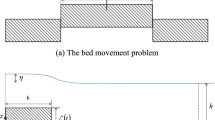Abstract
We derive an asymptotic equation governing the trans-ocean propagation of tsunami from source to the continental shelf. Focus is on disturbances originated from a slender fault of finite length. The variable sea depth is assumed to consist of a slowly varying mean and random fluctuations. The method of multiple scales is used to derive a Kadomtsev–Petviashvili equation with variable coefficients. Modifications by one- and two-dimensional random irregularities are shown to affect the wave speed, dissipation and additional dispersion. The result can be used to facilitate physical insight with modest numerical efforts.

Similar content being viewed by others
Notes
Alternatively we can define the correlation as \(\widehat{\varGamma }(x^{\prime}-x)=\langle b(x)b(x^{\prime})\rangle\) which is related to \(\varGamma (\bar{x}-\bar{x}^{\prime})\) by \(\widehat{\varGamma }(x^{\prime}-x)=\varGamma (h(X)(\bar{x}^{\prime}-\bar{x}))\).
References
Ablowitz M, Clarkson PA (1991) Solitions, nonlinear evolution equations and inverse scattering. Cambridge University Press, Cambridge
Barnard EN, Robinson AR (2009) The Sea, vol. 15, Tsunami. McGraw-Hill, New York
Bell TH (1975) Statistical features of sea floor topography. Deep Sea Res 22(12):883–892
Bühler O, Holmes-Cerfon M (2011) Decay of an internal tide due to random topography in the ocean. J Fluid Mech 678:271–293
Carrier GF, Greenspan H (1957) Water waves of finite amplitude on a sloping beach. J Fluid Mech 4:97–109
Carrier GF, Yeh H (2005) Tsunami propagation from a finite source. Comput Math Eng Sci 10(2):113–121
Chen Q, Kirby JT, Dalrymple RA, Kennedy AB, Chawla A (2000) Boussinesq modeling of wave transformation, breaking, and runup. II: 2D. J Waterw Port Coast Ocean Eng 126(1):48–56
Chen XN, Liu YZ (1988) Diffraction of a solitary wave by a thin wedge. Acta Mech Sin 4(3):201–210
Chen X-N, Sharma SD (1995) A slender ship moving at a near-critical speed in a shallow channel. J Fluid Mech 291:263–285
Choi HS, Bai KJ, Kim JW, Cho IH (1991) Nonlinear free surface waves due to a ship moving near the critical speed in shallow water. In: 18th Symposium on naval hydrodynamics, pp 173–189
Choi HS, Mei CC (1989) Wave resistance and squat of a slender ship moving near the critical speed in restricted water. In: Fifth international conference on numerical ship hydrodynamics, pp 439–452
Duffy DG (2001) Green’s functions with applications. Chapman & Hall, London
Dutykh D, Labart C (2011) Long wave run-up on beaches. Phys Rev Lett 107:187504
Elter JF, Molyneux JE (1972) The long-distance propagation of shallow water waves over an ocean of random depth. J Fluid Mech 53:1–15
Goff JA, Jordan TH (1988) Stochastic modeling of seafloor morphology: inversion of sea beam data for second order statistics. J Geophys Res 93(B11):13589–13608
Grataloup GL, Mei CC (2003) Localization of harmonics generated in nonlinear shallow water waves. Phys Rev E 68:026314
Grilli ST (2011) Numerical simulation of the 2011 Tohoku tsunami based on a new transient FEM co-seismic source: comparison to far- and near-field observations. Pure Appl Geophys 170(6–8):1333–1359
Hammack JI, Segur H (1978) Modelling criteria for long water waves. J Fluid Mech 84:359–373
Johnson RS (1972) Some numerical solutions of a variable-coefficient Korteweg-de Vries equation (with applications to solitary wave development on a shelf). J Fluid Mech 54(1):81–91
Johnson RS (1973) On the development of a solitary wave over an uneven bottom. Proc Camb Philos Soc 73:183–203
Kajiura K (1963) The leading wave of a tsunami. Bull Earthq Res Inst Univ Tokyo 41:525–571
Kakutani T (1971) Effect of an uneven bottom on gravity waves. J Phys Soc Jpn 30:272–276
Kanoglu U (2004) Nonlinear evolution and runup/rundown of long waves over a sloping beach. J Fluid Mech 513:363–372
Katsis C, Akylas TR (1987) On the excitation of long nonlinear water waves by a moving pressure distribution. Part 2. Three-dimensional effects. J Fluid Mech 177:49–65
Kawahara T (1976) Effect of random inhomogeneities on nonlinear propagation of water waves. J Phys Soc Jpn 41:1402
Kennedy AB, Chen Q, Kirby JT, Dalrymple RA (2000) Boussinesq modeling of wave transformation, breaking, and runup. I: 1D. J Waterw Port Coast Ocean Eng 126(1):39–47
Lee SJ, Grimshaw RHJ (1990) Upstream-advancing waves generated by three-dimensional moving disturbances. Phy Fluids A2:194–201
Li Y, Mei CC (2014) Scattering of internal tides by irregular bathymetry of large extent. J Fluid Mech 747:481–505
Liu PL-F, Yeh H, Synolakis CE (2008) Advanced numerical models for simulating tsunami waves and runup-advances in coastal and ocean engineering: vol 10. World Scientific, Singapore
Madsen OS, Mei CC (1969) The transformation of a solitary wave over an uneven bottom. J Fluid Mech 39:781–791
Mei CC, Hancock MJ (2003) Weakly nonlinear surface waves over a random seabed. J Fluid Mech 475:247
Papoulis A (1965) Probability, random variables and stochastic processes. McGraw-Hill, Nwe York
Pihl J, Mei CC, Hancock MJ (2002) Surface gravity waves over a two dimensional random seabed. Phys Rev E 66:016611
Mei CC, Li Y (2004) Evolution of solitons over a randomly rough seabed. Phys Rev E 70(016302):1–11
Mei CC, Li Y-L, Wang B-L (2016) Two-dimensional evolution of tsunami from a slender fault in a sea of variable depth. Sub Judice
Miles JW (1979) On the Korteweg-deVries equation for gradually varying channel. J Fluid Mech 91:181–190
Nachbin A (1995) The localization length of randomly scattered water waves. J Fluid Mech 296:353–372
Nachbin A, Papanicolaou GC (1992) Water waves in shallow channels of rapidly varying depth. J Fluid Mech 241:311–332
Novikov S, Manakov SV, Pitaevskii LP, Zakharov VE (1988) Theory of solitons, the inverse scattering method. Consultants Bureau, London
Pelinovsky E, Razin A, Sasorova EV (1998) Berkhoff approximation in a problem on surface gravity wave propagation in a basin with bottom irregularities. Waves Random Media 8:255–258
Rosales RR, Papanicolaou GC (1983) Gravity waves in a channel with a rough bottom. Stud Appl Maths 68:89–102
Rybkin A, Pelinovsky E, Didenkulova Ira (2014) Nonlinear wave run-up in bays of arbitrary cross-section. J Fluid Mech 748:416–432
Tappert FD, Zabusky NJ (1971) Gradient induced fission of solitons. Phys Rev Lett 27:1174–1776
Trefethen LN (2000) Spectral methods in MATLAB. SIAM, Philadelphia
Wang X, Liu PL-F (2006) An analysis of 2004 Sumatra earthquake fault plane mechanisms and Indian Ocean tsunami. J Hydraul Res 44(2):147–154
Watts P, Ioualalen M, Grilli S, Shi F-Y, Kirby JT (2005) Numerical simulation of the December 26, 2004 Indian Ocean tsunami using a higher-order Boussinesq model. In: Fifth international symposium waves 2005, pp 1–10, Madrid
Author information
Authors and Affiliations
Corresponding author
Appendix: Equivalence of random forcing term in 1D
Appendix: Equivalence of random forcing term in 1D
For constant mean depth (\(h=1\)), Mei and Li (2004) found the random forcing term to be,
where \(P(\xi )\) is
In this form the physical influence of random scattering is clear. The first term represents reduction in phase speed. The second and the third terms give rise to dissipation, while the last term augments dispersion. Let us prove that it is equivalent to (4.16).
Note first that
Let us start from (4.16)
Equation (4.16) becomes
By letting \(\sigma ^{\prime} = \sigma +2\xi\), (7.1) is recovered.
Rights and permissions
About this article
Cite this article
Li, Y., Mei, C.C. Modified Kadomtsev–Petviashvili equation for tsunami over irregular seabed. Nat Hazards 84 (Suppl 2), 513–528 (2016). https://doi.org/10.1007/s11069-016-2450-6
Received:
Accepted:
Published:
Issue Date:
DOI: https://doi.org/10.1007/s11069-016-2450-6




